Are HSE Students Prepared for Life After High School?
By Kellie Kelly
The Indiana Commission for Higher Education is responsible for developing goals that “provide every Hoosier student the opportunity to obtain a quality degree or credential.” Indiana’s Big Goal is “for 60 percent of working age Hoosiers to have a quality degree or credential by 2025.” In order to see if Indiana is meeting this goal, the Commission for Higher Education maintains statistics on “post secondary education outcomes.” You can research this data at www.in.gov/che/college- readiness-reports.
This data is very valuable due to the fact that it has been recorded starting with the high school graduating class, or cohort, of 2008. So, there is a history of data to search for trends. Also, you can easily navigate and view the scorecards for individual school districts in order to see how your particular school district is performing. You can view the Hamilton Southeastern Schools College Readiness Scorecard for 2022 to the right.
In an online school board candidate forum, Julie
Chambers, a candidate running for re-election,
made the following comments. “Overall, I believe
HSE does an excellent job of preparing our students for life after high school.” “Just under 75% of our students enrolled in a four-year
college or university, and 95.8% of those students did NOT need remediation courses and 62.3% completed 4 years of public college on time.”
Let’s look at the statistics from the Commission of Higher Education to fact check this data. First, let’s discuss the 95.8% of students not needing remediation. The Commission of Higher Education looks at three benchmarks to determine early college success: the percentage of students not needing remediation, the percentage of students completing all coursework attempted, and the percentage of students persisting to the second year. They combine these three benchmarks to determine an early college success score. HSE’s early college success score is only 59.3%. A table showing early college success scores for neighboring school districts is helpful for comparison to determine if HSE is doing well with this metric. See the table below.
It is inaccurate for Ms. Chambers to cite only one part of a three part benchmark in order to make an argument that HSE schools are doing an excellent job. Looking at all three components of the early college success benchmark paints a different picture. Only choosing data to support your argument while ignoring other data is called cherry-picking. Cherry-picking data leads to incorrect analysis and poor decision- making.
Next, let’s look at the percentage of students enrolled in college. Ms. Chambers is correct that just under 75%, or 74.4% to be exact, of HSE students from the 2020 graduating class are enrolled in college. However, without relating that number to other school district percentages or with other graduating class percentages, there is no way to determine if that is a good or bad statistic.
Let’s look at the historical data for Hamilton Southeastern Schools. A line graph for the percentages of HSE students enrolled in college from the graduating classes of 2008 to 2020 shows a rapid decline. HSE’s greatest percentage of students enrolled in college was 85.9% with the graduating class of 2012. 74.4% is NOT a percentage which should encourage parents to believe that HSE Schools under the current School Board and Administration are doing a good job to prepare students for life after high school.
This is just one more declining statistic along with declining standardized test scores, declining math scores, declining IREAD-3 scores for two of our elementary schools, and now declining percentages of students enrolled in college. We need new School Board Members to re-focus our schools on academics not activism. Vote for candidates who want to put academic excellence back in our schools. With your help we can turn things around in order to see these graphs go up, not down.





